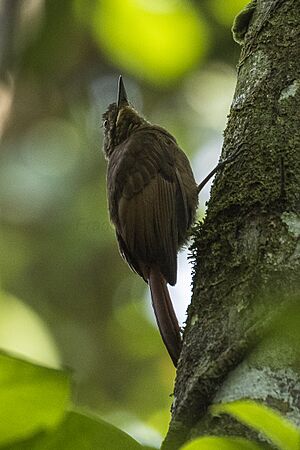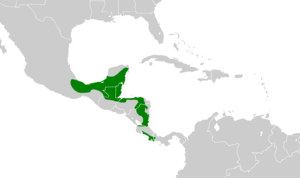Tawny-winged woodcreeper facts for kids
Quick facts for kids Tawny-winged woodcreeper |
|
|---|---|
 |
|
| Conservation status | |
| Scientific classification | |
| Genus: |
Dendrocincla
|
| Species: |
anabatina
|
 |
|
The tawny-winged woodcreeper (Dendrocincla anabatina) is a type of passerine bird found in Central America. It lives in countries like Belize, Costa Rica, Guatemala, Honduras, Mexico, Nicaragua, and Panama. This bird is part of the ovenbird family called Furnariidae. It's known for its brownish feathers and its special way of finding food by following army ants.
Contents
About the Tawny-winged Woodcreeper
The tawny-winged woodcreeper is a medium-sized bird. It grows to be about 17 to 19 centimeters (about 7 inches) long. Male birds usually weigh between 34 to 42 grams, while females are a bit lighter, weighing 29 to 39 grams.
What Does It Look Like?
This bird has a straight beak and a short tail. Its head is brown with light buffy stripes above its eyes. The skin around its eyes is gray. The top of its head, neck, and back are dark olive-brown. Its tail feathers are a reddish-brown color.
The feathers on its wings are dark olive-brown, and its flight feathers are a tawny (light brownish-orange) color with dark tips. Its throat is pale buff, and its belly is a light olive-brown, turning cinnamon (a reddish-brown) towards its tail.
The bird's eyes can be yellowish-brown or gray. Its upper beak is dark brown or black, and its lower beak is gray or bluish. Its legs and feet are dark blue-gray or blackish. Young birds look similar to adults but might have a duller throat and a wider stripe above their eyes.
Different Types of Tawny-winged Woodcreepers
There are three main types, or subspecies, of the tawny-winged woodcreeper:
- D. a. anabatina
- D. a. typhla
- D. a. saturata
These different types have slight differences in their feather colors. For example, D. a. typhla is paler (lighter) than the main type, especially on its belly. D. a. saturata has darker, more olive-colored feathers on its upper body.
Where Do They Live?
The tawny-winged woodcreeper lives in different parts of Central America.
- The main type, D. a. anabatina, is found along the Caribbean coast from southern Mexico down through Belize, Guatemala, and Honduras to eastern Nicaragua.
- D. a. typhla lives in the Yucatán Peninsula, which is part of Mexico.
- D. a. saturata is found on the Pacific coast, from Costa Rica into Panama.
Their Home Environment
These birds mostly live in thick, humid evergreen forests. They also live in areas where the forest meets open spaces. In the Yucatán Peninsula, they can be found in forests that lose some of their leaves during dry seasons. In Costa Rica, they even live in mangrove forests.
Tawny-winged woodcreepers usually stay close to the ground. They are mostly found at elevations below 500 meters (about 1,640 feet). However, they can live as high as 1,200 meters (about 3,900 feet) in Mexico and northern Central America, and up to 1,500 meters (about 4,900 feet) in Costa Rica.
How They Live
Movement and Daily Life
The tawny-winged woodcreeper stays in the same area all year round. It does not migrate (move to different places for seasons).
What Do They Eat?
This bird has a very interesting way of finding food! It mostly follows army ant swarms. As the army ants move, they disturb insects and other small creatures. The woodcreeper then swoops down to catch them. It usually perches on a branch or tree trunk up to 3 meters (about 10 feet) above the ground. From there, it makes short flights to the ground to grab its prey.
They eat many different kinds of arthropods (like insects and spiders). Sometimes, they also eat small animals like lizards and even some fruit. It's important to know that they do not eat the army ants themselves! These birds usually hunt alone or in pairs. They can be quite aggressive towards other birds, even other woodcreepers, when they are feeding.
Reproduction and Life Cycle
The breeding season for the tawny-winged woodcreeper happens between March and July, though the exact timing can vary a bit depending on the location.
They build their nests in holes found in tree stumps, tree trunks, or palm trunks. Most of these holes are natural, but some might be old holes made by woodpeckers. The inside of the nest is lined with soft materials like moss and fibers.
A female woodcreeper usually lays two eggs. The eggs hatch after about 20 to 21 days. The young birds are ready to leave the nest about 24 days after they hatch. It seems that only the female bird builds the nest, sits on the eggs to keep them warm, and feeds the baby birds.
Bird Calls and Songs
The tawny-winged woodcreeper has a long, rattling song. It sounds like "whee-whee-whee-whee..." and can last for more than a minute! They also make different calls, such as a sad-sounding "squirp," "deyeew," "cheeuw," and "tchee-u." Another call sounds like an strong "TEAURRR!"
Status and Conservation
The IUCN (International Union for Conservation of Nature) has listed the tawny-winged woodcreeper as a species of "Least Concern." This means they are not currently in danger of disappearing.
This bird lives across a large area, and there are estimated to be between 50,000 and 500,000 adult birds. However, this number is thought to be slowly going down. No immediate big threats have been found for them.
They are generally quite common in most places they live, except for the Yucatán Peninsula, where they are rare. While many woodcreepers are very sensitive to changes in their forest homes, there is some evidence that the tawny-winged woodcreeper can handle some disturbance to its habitat.


